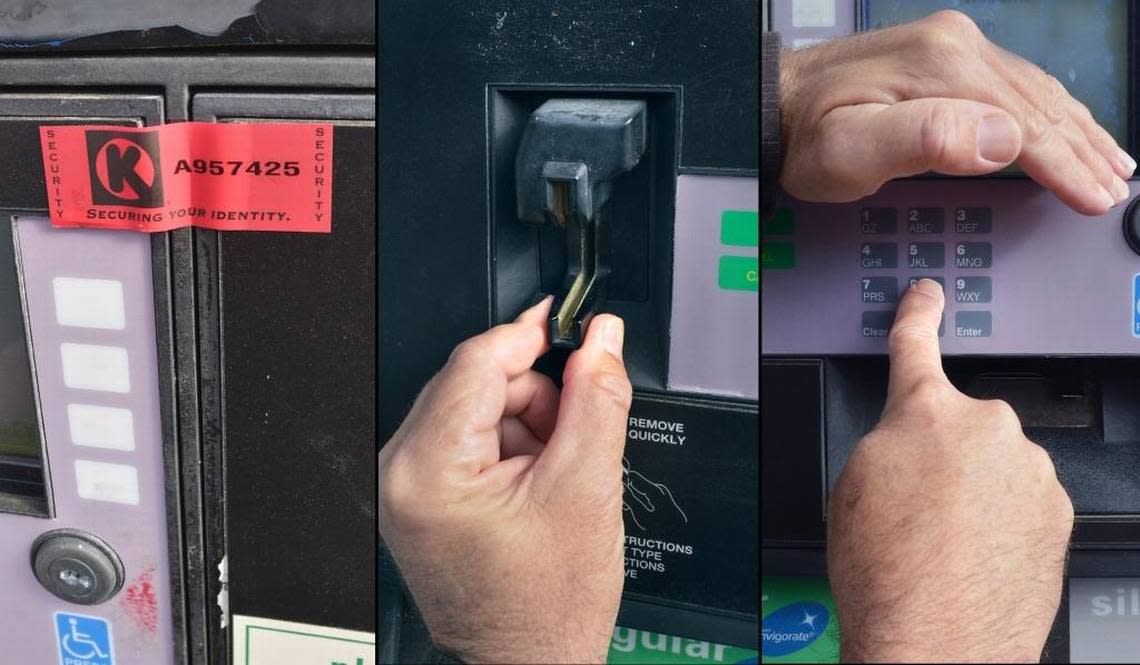Avoid being a victim of credit card skimmers in Texas as schemes become ‘harder to find’

Texas, Florida and California are the states with the most credit card skimming cases in the U.S.
Last year, the Texas Department of Licensing and Regulation reported about 400 gas pump skimmers.
“The type of equipment that the criminals are using to build their skimmers is changing, and it’s making it harder to find,” says Adam Colby, director and chief investigator of the Texas Financial Crimes Intelligence Center, launched in January 2022 to track financial organized crime across Texas. “I suspect that we probably just found a fraction of what was actually out there.”
Gas pump skimming alone results in losses of about $400 million a year in Texas, according to the FCIC. The agency says one card company lost $1 to $3 million a month in Texas as a result of the crime.
The Star-Telegram reported in 2019 that three credit card skimmers were found at one gasoline station on Alta Mesa Boulevard. The discovery was reported to the authorities and investigated.
In 2020, suspects were arrested allegedly stealing several hundred card and pin numbers at a Hurst credit union ATM.
It used to be most common in only the large metropolitan areas of Texas, but now it’s just everywhere, Colby said. While it’s a crime that has been going on for the last two to three decades, Colby says “it’s just gotten very, very sophisticated.”
There are three types of credit card skimming: gas pump skimming, ATM skimming and point-of-sale skimming. ATM skimming and point-of-sale skimming are more concentrated in areas with larger populations because there are more cards to steal. While the FCIC has seen the two increase immensely in the last year, gas pump skimming has spread across different regions of Texas.
“The gas pump skimming is going to be pretty much anywhere where there’s a gas station,” Colby said. “It used to just be in the big cities, but now it’s down in the valley, it’s in West Texas, it’s everywhere.”
The FCIC gets skimming reports from the Texas Department of Licensing and Regulation, banks, fuel companies and retailers. A recent case with multiple smaller agencies outside of Harris County resulted in 16 arrest warrants being issues.
“What we will typically do is we will then work alongside of the local police department,” Colby said. “We do work some of our own cases, especially with smaller agencies that don’t really have experience with this stuff, so we’ll do all of the intelligence for them. We’ll figure out who’s doing what, track money movements and we help them build the case.”
Best ways to fight credit card skimmers in Texas
Using “tap to pay” is the best way for Texas residents to protect themselves from skimmer, Colby says. He also encourages individuals to check their balance regularly. You can also download your bank’s app and turn your card on and off or set alerts for when transactions occur. You’ll get a text message or notification saying a transaction is being attempted and respond yes if it was you or no if it was not.
If you are a victim of credit card skimming, report it to your local police department. When police departments don’t have the time or training to handle a case, they reach out to the FCIC, which then works with them to help build the case.
FBI tips to avoid credit card skimmers at the gas pump
Choose a fuel pump that is closer to the store and in direct view of the attendant. These pumps are less likely to be targets for skimmers.
Run your debit card as a credit card. If that’s not an option, cover the keypad when you enter your PIN.
Consider paying inside with the attendant, not outside at the pump.
FBI tips to avoid credit card skimmers at ATMs, point-of-sale terminals
Inspect ATMs, point-of-sale terminals, and other card readers before using. Look for anything loose, crooked, damaged, or scratched. Don’t use any card reader if you notice anything unusual.
Pull at the edges of the keypad before entering your PIN. Then, cover the keypad when you enter your PIN to prevent cameras from recording your entry.
Use ATMs in a well-lit, indoor location, which are less vulnerable targets.
Be alert for skimming devices in tourist areas, which are popular targets.
Use debit and credit cards with chip technology. In the U.S., there are fewer devices that steal chip data versus magnetic strip data.
Avoid using your debit card when you have linked accounts. Use a credit card instead.
Contact your financial institution if the ATM doesn’t return your card after you end or cancel a transaction.

